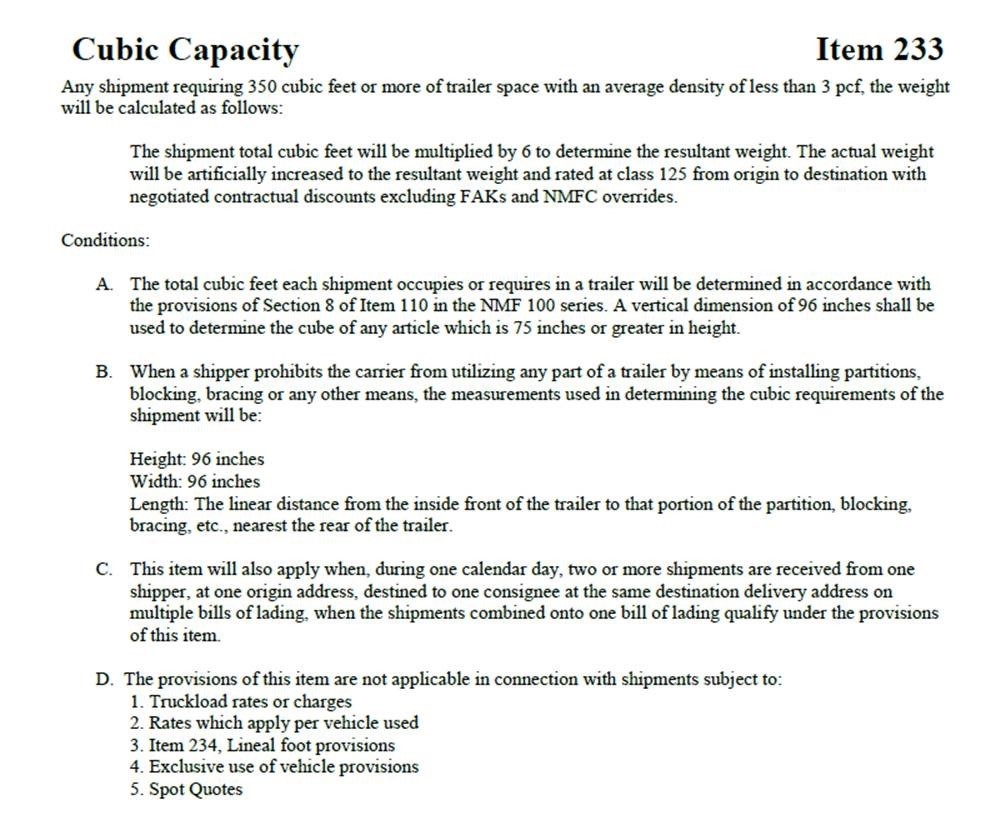Remember the National Motor Freight Classification® (NMFC®) is a standard that provides a comparison of commodities moving in interstate, intrastate and foreign commerce. Commodities are grouped into one of 18 classes—from a low of class 50 to a high of class 500—based on an evaluation of four transportation characteristics: density, stow-ability, handling, and liability. Together, these characteristics establish a commodity’s “transportability.”
These characteristics can be defined as follows:
- Density (Weight, Length, & Height): Density is the space the item occupies in relation to its weight. The density is calculated by dividing the weight of the item in pounds by its volume in cubic feet. Your item’s volume in cubic feet is Length x Width x Height/1,728, where all dimensions are measured in inches. The density of your item = Weight/Volume, where Weight is measured in pounds and Volume is measured in cubic feet.
- Stow-ability: Most freight stows well in trucks, trains and boats, but some articles are regulated by the government or carrier policies. Some items cannot be loaded together. Hazardous materials are transported in specific manners. Excessive weight, length or protrusions can make freight impossible to load with other freight. The absence of load-bearing surfaces makes freight impossible to stack. A quantifiable stow-ability classification represents the difficulty in loading and carrying these items.
- Handling: Most freight is loaded with mechanical equipment and poses no handling difficulties, but some freight, due to weight, shape, fragility or hazardous properties, requires special attention. A classification that represents ease or difficulty of loading and carrying the freight is assigned to the items.
- Liability: Liability is probability of freight theft or damage, or damage to adjacent freight. Perishable cargo or cargo prone to spontaneous combustion or explosion is classified based on liability and assigned a value per pound, which is a fraction of the carrier’s liability. When classification is based on liability, density must also be considered.
Sub-NMFC Codes
Yes,
there is more! There are also Sub-NMFC codes which are noted with a dash after
the code (i.e. 41024-04). Make sure to confirm that the Sub-NMFC code matches
the correct freight class. Carriers sometimes overlook this, but it’s also
not uncommon for them to charge you at the higher class; whether it be the
class that was listed, or the class corresponding to the Sub-NMFC codes on the
BOL. These can often be disputed, but usually require a manufacturer’s
specification sheet and a packing list proving the correct class. That’s more
work for all parties and can be avoided by simply double-checking to make sure
your class and NMFC code match.
Don’t forget we are participants of the National Motor Freight Traffic Association which means we have access to multiple ways of obtaining the correct NMFC number/code for your shipments. If you have any questions or doubts regarding your product’s freight class, please reach out to the LTL Team.


